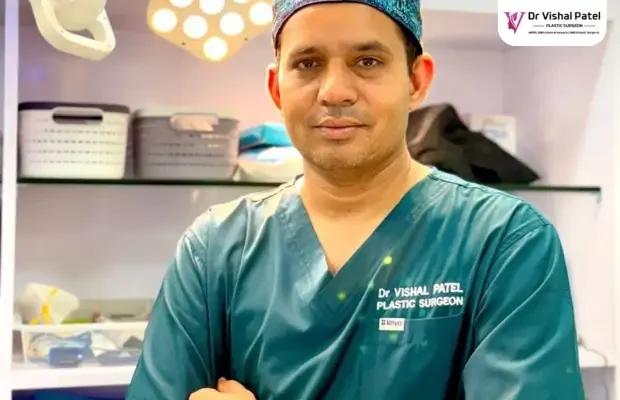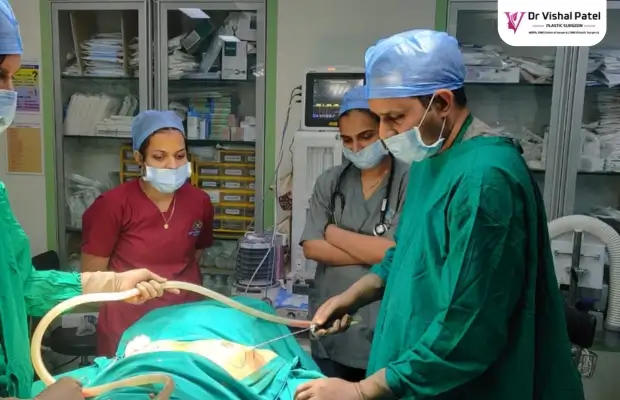
Acne scars happens due to various types of things that happen to your skin which includes having a severe form of acne. Acne scars affects your confidence and self-esteem as they are visible to normal eyes due to their easy to see appearance.
Off course you might have gone through various type of acne scar treatment in Mumbai including Laser acne scar treatment.
But there is a new thing in the market known as “Fat grafting for Acne Scars”. Fat grafting for acne scars has emerged as a highly effective and natural solution for treatment of Acne scars in Mumbai. It’s one of popular scar revision surgery in Mumbai offered by various plastic surgeons.
This procedure uses your own fat to fill in scars and thereby helps in giving you smoother and more even skin. This complete guide on Fat grafting for Acne scars treatment, will help you understand everything if you are thinking about this treatment. So, let’s get started –
What is Fat Grafting for Acne Scars?

Fat grafting for acne scars is also known as fat transfer or fat injection. It is a face plastic surgery procedure that uses your own fat to improve the appearance of acne scars.
This technique is very effective for atrophic (indented) scars. During the fat grafting for acne scars surgery, fat is harvested from another part of your body and then processed before being injected into the acne scars on face.
This fat transfer or fat grafting helps to add volume to the scars, making them less noticeable and improving overall skin texture.
Many people in Mumbai near Juhu, Andheri, Bandra and various nearby areas look for fat grafting for face procedures to address problems related to acne and pimples, skin breakouts, chronic acne, or severe acne and all other types of pimple problem.
Facial fat grafting for acne scars adds volume and promote skin rejuvenation. The facial fat grafting before and after results can show a significant improvement in the appearance of acne scars.
Why Choose Fat Grafting for Acne Scars?
Natural Solution: Uses your own fat which helps in reducing the risk of allergic reactions.
Long-Lasting Results: Fat cells can integrate into the skin providing permanent to last longing improvement.
Dual Benefit: Removes unwanted fat from one area and improves skin texture in another.
There are various types of Fat grafting for Acne scars but 2 of those of widely used. These includes Micro fat grafting for Acne scars & Nano fat grafting for Acne scars. Let’s have a look at them in detail.
Contact Us for Best Fat Grafting for Acne Scars Treatment in Mumbai
9004983316
Video - Fat Grafting for Acne Scars in India
Checkout below informative video made by Dr. Vishal Patel. He explains what is Fat grafting for Acne Scars and how the process is carried out.
He also explains how the treatment is useful in treatment of your stubborn acne scars that don’t respond to Laser acne scar treatment in Mumbai or any other type of acne scar treatment in India.
Micro Fat Grafting for Acne Scars

Micro fat grafting for acne scars is an advanced fat grafting type which uses smaller amounts of processed fat for injection.
The Micro fat transfer method is good for treating delicate areas and superficial scars. This method offers more precise placement and improved results compared to traditional fat grafting for acne scars.
In this procedure, the plastic surgeon or acne specialist harvest a small amount of fat, basically from areas like the abdomen or thighs, and processing it to create micro-fat particles.
These particles are then injected into the acne scars using fine needles, stimulating collagen production and improving skin texture. Micro fat grafting is a popular option for those seeking a natural and long-lasting solution to acne scarring.
Benefits of Micro Fat Grafting for Acne Scars
Precision: Micro fat grafting technique targets even the smallest and deepest acne scars.
Natural Look: Facial pimples or scars blends naturally with surrounding skin.
Minimal Downtime: Quick recovery compared to other Acne scar treatments in Mumbai.
Contact Us for Best Fat Grafting for Acne Scars Treatment in Mumbai
9004983316
Nano Fat Grafting for Acne Scars

Nano fat grafting for acne scars is more hi-tech technique that takes fat grafting a step further. It involves processing the harvested fat even more extensively than micro fat grafting.
As a result of this procedure the plastic surgeon aim to create nano-fat particles. These nano-fat particles are rich in growth factors and stem cells.
This will be very beneficial for improving skin quality, texture, and treating very superficial acne scars. Nano fat grafting for acne scars is a minimally invasive procedure that can offer noticeable and long-lasting results.
Why Prefer Nano Fat Grafting for Acne Scars?
Enhanced Results: Nano fat grafting for Acne pimples Improves skin elasticity and texture.
Stem Cell Benefits: The fat grafted during nano fat grafting Contains regenerative cells that promote skin healing.
Versatile: Nono fat grafting for acne can be used on the face, chest, and other areas with scars
Bacon Fat for Acne ? Really?
While bacon fat is not used in medical treatments, the concept of using natural fats for skin improvement has inspired procedures like fat grafting. Always consult a qualified acne surgeon in Mumbai for safe and effective treatments.
Is facial fat grafting safe?
Facial fat grafting is safe when performed by a qualified and experienced surgeon. In that too, if a surgeon is a board certified plastic surgeon like Dr. Vishal Patel in Mumbai, then you can expect highest quality of standards during the treatment. However, like any procedure, it carries some risks, such as:
- Swelling and bruising
- Infection
- Asymmetry
- Fat reabsorption
Cost of Fat Grafting for Acne Scars in India

The cost of fat grafting for acne scars in India specially in Mumbai varies depending on the extent of scarring and the surgeon’s expertise.
The cost of fat grafting for acne scars treatment can vary significantly, depending on several factors. These include the extent of the scarring, the amount of fat that needs to be harvested, the surgeon’s expertise, and the clinic’s location.
On an average, the cost for fat grafting for acne scar ranges from Rs. 50000 to Rs. 1,50,000. This equates to around $600 – $2400+ (This is a broad estimate, and the actual cost can vary significantly).
Why does the cost of Fat Grafting for Acne scars vary?
- Extent of Scarring: More severe scarring requires more fat grafting, increasing the overall cost of acne scars fat grafting.
- Fat Harvesting: The amount of fat harvested and the technique used can influence the price of fat grafting treatment for Acne scars.
- Surgeon’s Expertise: Experienced surgeons with specialized skills often charge higher fees for fat grafting surgery for Acne scars.
Average cost of fat grafting for acne scars in India
The average cost of fat grafting for acne scars in India ranges from ₹50,000 to ₹2,00,000 (approximately $600 – $2400 USD).
This average fat grafting cost covers a range of scar severities and treatment areas. We have considered the cost in various tier 1 cities in India which includes Bangalore, Delhi, Mumbai & Hyderabad. Depending on the location, the cost of infra adds up and the prices for fat grafting treatment varies city by city.
Cost of Nano fat grafting for acne scars in India
Nano fat grafting for acne scar is a more specialized technique which is gaining more attention for acne scar treatment in Mumbai India. The cost of Nano fat grafting for acne scar typically ranges between ₹70,000 and ₹2,50,000 (approximately $840 – $3000 USD) in India. The nano fat grafting cost is due to the advanced processing of the fat and its application.
Cost of fat grafting for boxcar scars
Fat grafting for boxcar scars can range from ₹50,000 to ₹1,80,000 (approximately $600 – $2160 USD). The fat grafting cost for boxcar scars depends on the depth and size of these specific scars. Your acne specialist in Mumbai can guide you to choose between Micro fat grafting vs Nano fat grafting for treatment of Boxcar scars in India.
Cost of fat grafting for rolling scars
The cost of fat grafting for rolling scars in India is around between ₹40,000 and ₹1,50,000 (approximately $480 – $1800 USD). The fat grafting cost for rolling scars is often lower due to the nature of these less indented scars. It is comparatively easy than other type of scars and that’ why the prices are lower for rolling scars treatment in India.
Cost of fat grafting for Ice pick scars
Ice pick scars requires more precise filling and fat grafting treatments is one of best treatment to get rid of them. The cost of fat grafting for Ice pick scars ranges from ₹60,000 to ₹2,00,000 (approximately $720 – $2400 USD). The fat grafting cost for ice pick scars is for the detailed work required for these deep, narrow scars.
Our Pro Tip to Reduce Cost of Fat Grafting for Acne Scars
Inquire About Package Deals: Some clinics like Dr. Vishal Patel's offer package deals that include the procedure, pre- and post-operative care, and sometimes even medications. These packages can be more economical than paying for each element individually.
FAQs on Fat Grafting for Acne Scars
How much does fat grafting for acne scars cost?
The cost of fat grafting for acne scars in Mumbai can vary, typically ranging from ₹50,000 to ₹2,00,000 (approximately $600 – $2400 USD). This depends on the extent of scarring, the area treated (e.g., cheeks, forehead), the number of sessions needed, and the clinic’s fees. Dr. Vishal Patel can provide a personalized cost estimate during your consultation at his clinic in Goregaon and Malad Mumbai.
How long does fat grafting last in the face?
Fat grafting results in the face, including for acne scar treatment, are generally long-lasting, often several years. While not entirely permanent, the improvements can last for a considerable time. Dr. Vishal Patel can discuss realistic expectations for longevity during your consultation.
Can facial scars be removed permanently?
Complete removal of facial scars is often not possible. However, plastic surgery can significantly improve their appearance, making them less noticeable. The goal is often to minimize the scar’s visibility rather than eliminate it entirely
Is fixing acne scars expensive?
The cost of acne scar treatment varies widely depending on the type and severity of the scars, the chosen procedure, and the clinic. Some treatments are more expensive than others. It’s best to consult with Dr. Vishal Patel to get a personalized cost estimate and discuss financing options if available.
How many sessions of fat grafting?
For acne scar treatment, fat grafting usually requires 1-2 sessions. Dr. Vishal Patel will determine the appropriate number of sessions during your consultation based on the extent of your scarring
Can I wash my face after fat grafting?
You will receive specific aftercare instructions from Dr. Vishal Patel. Generally, gentle cleansing is allowed after a few days, but harsh scrubbing should be avoided. Proper aftercare is crucial for optimal healing and results.
Conclusion - Fat Grafting for Acne Scars
Fat grafting for acne scars is a safe, natural, and effective way to achieve smoother, scar-free skin. You can choose from various options of fat grafting surgery. This includes Micro fat grafting for acne scars, Nano fat grafting for acne scars, or traditional fat transfer.
This procedure offers long-lasting results and a boost in confidence. This is one of the latest technique for treatment of acne scars in Mumbai and India. If done by a board certified plastic surgeon like Dr. Vishal Patel in Mumbai, you can expect good results.
Dr. Vishal Patel - Best Plastic Surgeon in Mumbai


Dr. Vishal Patel is widely recognized as the best plastic surgeon in Mumbai, with over a 11+ years of experience in cosmetic and reconstructive surgery. Known for his expertise, compassionate care, and exceptional results,
Dr. Patel has helped 10000+ patients achieve their aesthetic goals and regain their confidence with successful plastic surgeries in Mumbai. Dr. Patel specializes in a wide range of advanced plastic surgery procedures, including:
Breast Augmentation in Mumbai
Mommy Makeover in Mumbai
Hair transplant in Mumbai
He is a founder of Recon Plastic Surgery Clinic in Mumbai near Malad West.
Get Guaranteed Discount on Fat Grafting for Acne Scars in Mumbai
Get minimum 10% Off on consultation and surgery fees with Dr. Vishal Patel – A Board Certified Plastic Surgeon in Mumbai.
Book your appointment now!.
Step 1
Fill the form
Step 2
Fix Your Time Slot
Step 3
Mention about offer at Reception
Visit Us for Best Fat Grafting for Acne Scars in Mumbai
Recon Plastic Surgery & Physiotherapy Clinic,
302, Corporate Corner, Next to Dalmia College, Mandlik Nagar, Sunder Nagar, Malad West, Mumbai, Maharashtra 400064





